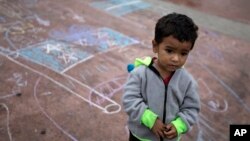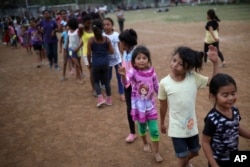The Trump administration is pushing back against news reports that it has lost track of almost 1,500 immigrant children who came to the United States as unaccompanied minors.
“The Unaccompanied Alien Children (UAC) Program was never intended … to be a foster care system. With more than 10,000 children in custody … the program has grown vastly beyond its original intention. HHS’s primary legal responsibility is to temporarily house and then release the UAC,” Steven Wagner, acting assistant assistant secretary at the Administration for Children and Families, told reporters in a Tuesday briefing.
The news first broke in late April during Senate testimony by an official of the Department of Health and Human Services.
In the month since, it has generated increasing public outrage over “missing children” and “toddlers being torn from their parents’ arms” on Twitter comments with the hashtag #WhereAreTheChildren.
And the story has given rise to some confusion.
What happened
The children were taken into government care after they showed up alone at the Southwest border. Most of the children are from Honduras, El Salvador and Guatemala, and were fleeing drug cartels, gang violence and domestic abuse.
HHS learned the 1,475 children could not be found after making follow-up calls last year to check on the safety of almost 8,000 children who had been placed with caretakers between October and December 2017.
The phone calls revealed that the majority of the children were still with their sponsors. Fifty-two had gone to live in different homes, 28 had run away and five had been deported. And 1,475 could not be accounted for.
Under a 1985 resolution — amended in 2015 — called the Flores Settlement Agreement, the federal government is required not to detain children if at all possible and instead release them “without unnecessary delay” into the care of a parent, legal guardian or other qualified adult.
Wagner told reporters that HHS went a step further than required by the Flores Settlement by making the follow-up phone calls. In the cases of the missing children, no one answered the phone.
“We do place kids with families that are themselves here illegally,” he said, “so you could imagine that many of those would not choose to speak to a federal official calling them on the phone. But there’s no reason to believe that anything has happened to the kids.”
Even critics of Trump administration policy concede that the children may be OK.
“A number of them may not be quote, unquote, missing,” Megan McKenna, senior director of communications and community engagement for Kids in Need of Defense (KIND), told VOA.
Where it gets confusing
Earlier this month, Attorney General Jeff Sessions announced that parents and children who together crossed the border illegally would be separated as part of a new “zero tolerance” policy, leading to the erroneous impression among the public that the unaccounted 1,475 had been taken from their parents and then lost, rather than crossing the border on their own.
On Saturday, President Donald Trump muddied the issue further by tweeting that parents and children were being separated at the border because of a “horrible law.”
But there is no law requiring parents and children to be separated. It is a “deliberate policy to separate children from their parents at the border,” Jennifer Podkul, KIND policy director, said at a second press briefing Tuesday.
Her organization estimates that “more than 600 kids in the last two weeks (since the policy went into effect) have been separated from their parents.”
Ironically, the new policy runs a very real risk that children will be lost in the system, according to Podkul, since it includes no ability for parents, who are in detention themselves, to communicate with or track their children. Phone calls are not allowed.
“If a parent is in U.S. marshals’ custody, it’s like a black hole,” added Michelle Brané, Women’s Refugee Commission migrant rights and justice director.
As a result, the policy turns children with families into unaccompanied minors, McKenna said, and puts them at risk for longer detention and then entry into foster care.
“We can imagine a situation where the kids do stay in custody longer because there’s no one then to release them to. And then, yes, they would end up in this kind of longer-term, long-term foster care, a situation until their cases were resolved or until a sponsor could be found,” McKenna said.
Loopholes
White House senior policy adviser Stephen Miller said the administration would prefer to detain parents and children together, but the lack of detention space, along with the specifications of the Flores agreement, are preventing that.
“Having enough detention space, along with terminating the Flores Settlement Agreement, would allow us to keep family units together until they are returned home,” he told reporters during the press briefing.
The Flores agreement is one of several “loopholes” Miller said he would like to see eliminated by Congress.
But “these protections and these procedures … were all designed to make sure that these kids get fair access to the U.S. immigration system, so they can ask us for protection in a way that recognizes that they’re kids, first and foremost, and that they aren’t the same as adults,” McKenna countered.






